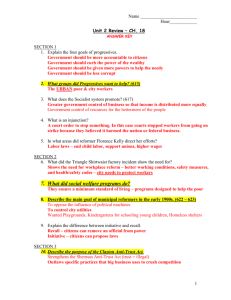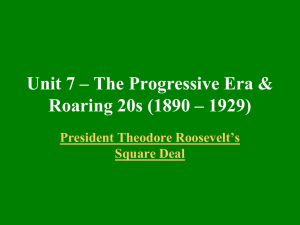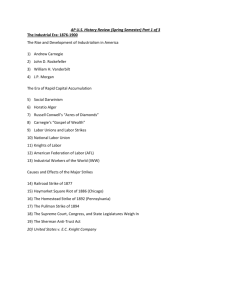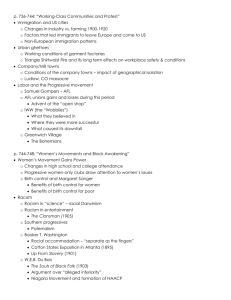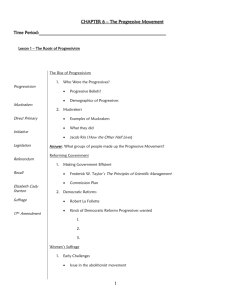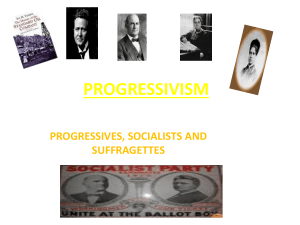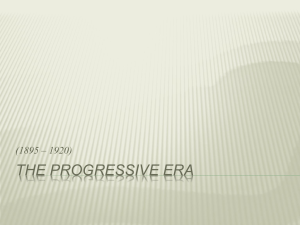File
advertisement
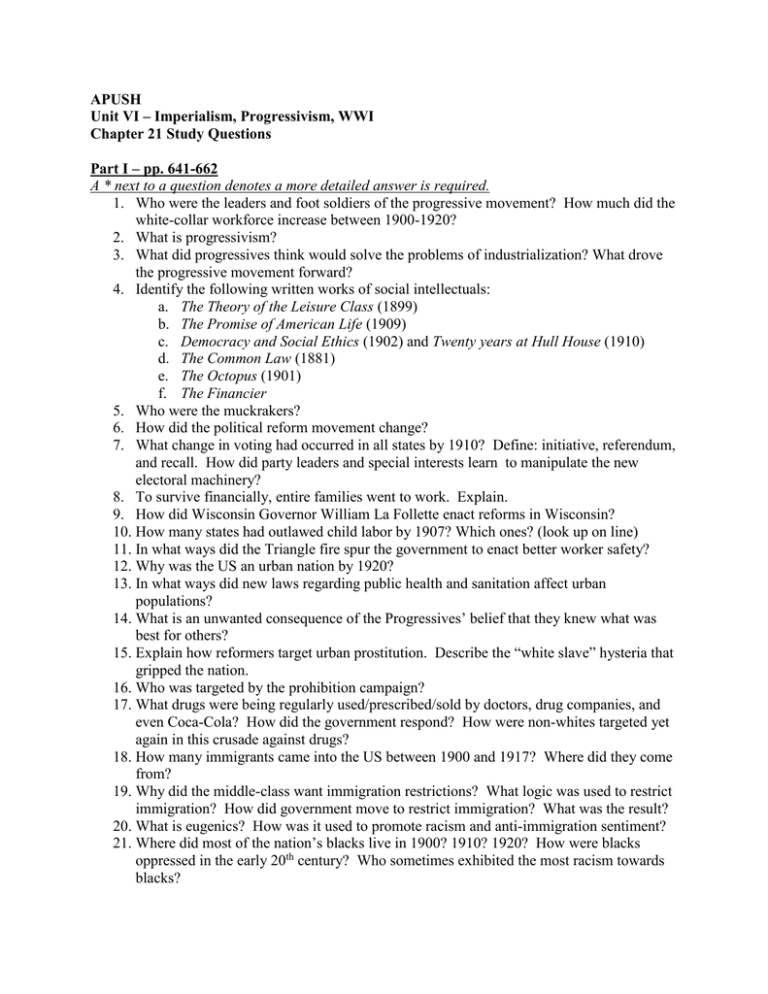
APUSH Unit VI – Imperialism, Progressivism, WWI Chapter 21 Study Questions Part I – pp. 641-662 A * next to a question denotes a more detailed answer is required. 1. Who were the leaders and foot soldiers of the progressive movement? How much did the white-collar workforce increase between 1900-1920? 2. What is progressivism? 3. What did progressives think would solve the problems of industrialization? What drove the progressive movement forward? 4. Identify the following written works of social intellectuals: a. The Theory of the Leisure Class (1899) b. The Promise of American Life (1909) c. Democracy and Social Ethics (1902) and Twenty years at Hull House (1910) d. The Common Law (1881) e. The Octopus (1901) f. The Financier 5. Who were the muckrakers? 6. How did the political reform movement change? 7. What change in voting had occurred in all states by 1910? Define: initiative, referendum, and recall. How did party leaders and special interests learn to manipulate the new electoral machinery? 8. To survive financially, entire families went to work. Explain. 9. How did Wisconsin Governor William La Follette enact reforms in Wisconsin? 10. How many states had outlawed child labor by 1907? Which ones? (look up on line) 11. In what ways did the Triangle fire spur the government to enact better worker safety? 12. Why was the US an urban nation by 1920? 13. In what ways did new laws regarding public health and sanitation affect urban populations? 14. What is an unwanted consequence of the Progressives’ belief that they knew what was best for others? 15. Explain how reformers target urban prostitution. Describe the “white slave” hysteria that gripped the nation. 16. Who was targeted by the prohibition campaign? 17. What drugs were being regularly used/prescribed/sold by doctors, drug companies, and even Coca-Cola? How did the government respond? How were non-whites targeted yet again in this crusade against drugs? 18. How many immigrants came into the US between 1900 and 1917? Where did they come from? 19. Why did the middle-class want immigration restrictions? What logic was used to restrict immigration? How did government move to restrict immigration? What was the result? 20. What is eugenics? How was it used to promote racism and anti-immigration sentiment? 21. Where did most of the nation’s blacks live in 1900? 1910? 1920? How were blacks oppressed in the early 20th century? Who sometimes exhibited the most racism towards blacks? 22. Describe D. W. Griffith’s The Birth of a Nation. 23. While blacks were being lynched, disenfranchised, and discriminated against, how were they viewed by progressives? 24. In W.E.B De Bois, The Souls of Black Folk, who and what was he criticizing? 25. What is the NAACP? Who formed it? What was its purpose? 26. Describe the women’s suffrage movement’s “Winning Plan”? What were its results? 27. What effect did the Progressive Era have on the issue of birth control? 28. How many workers were members of the AFL in 1920? Why did this number only represent 20% of the workforce? 29. Briefly describe the IWW. 30. Briefly describe the Socialist Party of America and Eugene V. Debs. Part II – pp. 662-673 Define: coalesce, jingoistic, bombastic 31. What goals did TR pursue when he became president? 32. How did TR handle the mine workers strike on 1902? 33. How was TR’s approach to labor disputes different than his predecessors? What were his feelings on big corporations? 34. What did Roosevelt announce in his 1902 State of the Union address? What is the “square deal? How many antitrust lawsuits were filed by the Roosevelt administration? What well known company was broken up in 1911? 35. What was the purpose of the Hepburn Act? What did it do? What was long-tern significance? 36. What was the purpose of Upton Sinclair’s The Jungle? How did the government respond to The Jungle? 37. Which African American dined with Teddy Roosevelt at the White House? 38. How much land was set aside for public use by presidents Harrison and Cleveland? 39. Define conservation. 40. What is the National Reclamation Act of 1902 (Newlands Act)? Explain why is it significant? 41. How much land did TR set aside as national forests, mineral reserves, and water power sites? As a result of Roosevelt’s creation of national parks, reserves and monuments, what was Congress forced to do in 1916? 42. Why was William Howard Taft the Republican nominee in 1908? 43. What did the Mann-Elkins Act of 1910 do? 44. What was Taft’s record in regard to antitrust cases? 45. What was the Ballinger-Pinchot? 46. Why did Taft win the Republican Party nomination in 1912? What is the Bull Moose Party and what was its platform? 47. Who won the Democratic Party nomination? What was his political vision? Why did he will the election of 1912? 48. Identify the following Wilson Era laws: a. *Federal Reserve Act of 1913 b. The Federal Trade Commission Act c. The Clayton Antitrust Act d. The Keating-Owen Act e. The Adamson Act f. The Workmen’s Compensation Act g. The Federal Farm Loan Act and the Federal Farm Warehouse Act h. The Federal Highway Act 49. Identify the following Wilson Era Constitutional victories: a. Muller v. Oregon b. The 16th Amendment c. The 17th Amendment d. The 18th Amendment e. The 19th Amendment 50. *How and why did the role of government change during the Progressive Era? Was it successful or unsuccessful?
